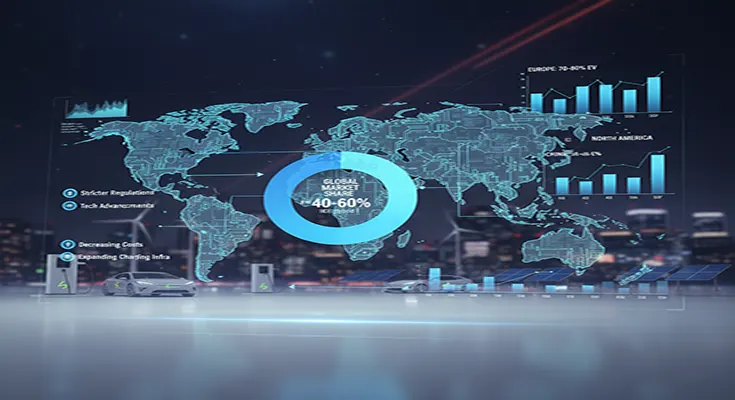The automotive industry is undergoing a monumental shift, with electric vehicles (EVs) rapidly moving from niche status to the mainstream.1 Driven by environmental concerns, technological advancements, and supportive government policies, the global EV market is poised for explosive growth over the next decade. While exact figures vary between analytical firms, the consensus is clear: EVs will command a significant portion of the total vehicle market by 2030.2
Current Landscape: A Glimpse of the Surge
In recent years, EV sales have surged dramatically, consistently breaking previous records.3 This growth is evident across various segments, from passenger cars to commercial vehicles. Tesla, a pioneer in the space, continues to be a dominant force, but traditional automakers like Volkswagen, General Motors, Hyundai, and BYD have rapidly scaled up their EV offerings, introducing compelling models that rival their internal combustion engine (ICE) counterparts in performance, range, and increasingly, affordability.
Government incentives, such as tax credits, subsidies, and charging infrastructure investments, have played a crucial role in accelerating adoption, particularly in key markets like China and Europe.4
Key Drivers Propelling EV Growth Towards 2030
Several factors are fueling the optimistic forecasts for EV market share:
- Stricter Emissions Regulations: Governments worldwide are implementing increasingly stringent emissions standards and even outright bans on the sale of new ICE vehicles in the coming years (e.g., California by 2035, various European nations by 2030-2040).5 This regulatory push is a primary catalyst for automakers to transition their product lines.6
- Technological Advancements:
- Battery Technology: Improvements in energy density, charging speed, and cost reduction are making EVs more competitive.7 Solid-state batteries, though still in development, promise even greater breakthroughs.
- Motor Efficiency: Electric motors are highly efficient, providing instant torque and a smooth driving experience.8
- Software Integration: EVs are essentially computers on wheels, allowing for over-the-air updates, advanced driver-assistance systems (ADAS), and seamless connectivity.9
- Decreasing Costs: While EVs often have a higher upfront cost than equivalent ICE vehicles, battery prices continue to fall.10 This, coupled with lower operating costs (cheaper “fuel,” reduced maintenance), is steadily eroding the total cost of ownership (TCO) gap. Many analysts predict price parity between EVs and ICE vehicles in certain segments before 2030.
- Expanding Charging Infrastructure: The “chicken and egg” problem of EVs and charging stations is being aggressively addressed.11 Governments, energy companies, and private entities are investing billions into building out extensive charging networks, including fast-charging hubs, making range anxiety less of a concern.12
- Increasing Consumer Acceptance: As more people experience EVs, either through ownership or ride-sharing, perceptions are shifting. The benefits of quiet operation, instant acceleration, and environmental responsibility are resonating with a growing segment of the population.
Global EV Market Share Forecast for 2030: The Projections
While forecasts vary, most reputable industry analyses predict that EVs will account for between 40% and 60% of new vehicle sales globally by 2030. Some even project higher in specific, aggressive markets.
Here’s a breakdown of common projections:
- BloombergNEF (BNEF): Often cited, BNEF’s projections have consistently been revised upwards. Their current outlook suggests that by 2030, EVs could represent around 50-60% of new passenger vehicle sales globally.
- IEA (International Energy Agency): The IEA also forecasts robust growth, with scenarios indicating that EVs could account for 40-50% of total car sales by 2030, with even higher shares in leading markets.13
- Deloitte: Deloitte’s analysis points to 31.1 million EV sales by 2030, which, depending on the total market size, would translate to a significant market share, potentially in the 40-50% range.
- Other Analysts (e.g., Wood Mackenzie, S&P Global): Many other firms align with these figures, generally predicting that by 2030, a large portion of new vehicles sold will be electric.
Regional Variations:
It’s important to note that this global average masks significant regional differences.
- Europe: Driven by ambitious climate targets and strong incentives, Europe is expected to have one of the highest EV market shares, potentially exceeding 70-80% of new sales in some countries by 2030.
- China: As the world’s largest automotive market and a strong proponent of EVs, China is also projected to see very high adoption rates, likely in the 50-60% range or higher.
- North America: While catching up, North America’s transition might be slightly slower than Europe’s, but significant growth is still expected, with EV market share likely reaching 40-50%.
- Other Regions: Developing markets will likely see slower but still substantial growth, as affordability and charging infrastructure become more widespread.
Challenges Ahead
Despite the optimistic outlook, challenges remain:
- Raw Material Supply: Ensuring a sustainable and ethical supply of critical battery materials (lithium, cobalt, nickel) will be crucial.
- Grid Capacity: While robust, the electrical grid will need continuous upgrades to handle the increased demand from widespread EV charging.14
- Recycling Infrastructure: Developing efficient and scalable battery recycling processes is essential for environmental sustainability.15
- Affordability in All Segments: While the cost gap is closing, making EVs truly affordable across all vehicle segments and income levels globally remains a goal.
The path to 2030 for the global automotive market is undoubtedly electric. The convergence of technological innovation, economic viability, and environmental imperative is creating an unstoppable momentum. While the precise figures may shift, the overarching trend is undeniable: electric vehicles are not just the future; they are rapidly becoming the present, fundamentally reshaping how we move and interact with our world.

